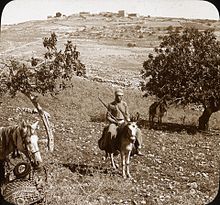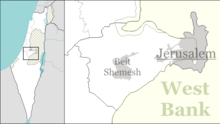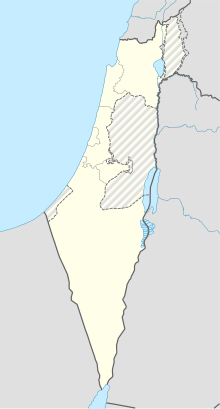Ramathaim-Zophim
רמתיים־צופים | |
 Ramah viewed from the south, image c. 1915 | |
| Alternative name | Ramah, Ramatha |
|---|---|
| Region | Southern Levant |
| Coordinates | 31°49′59″N 35°10′52″E / 31.833°N 35.181°E |
| Type | town |
| History | |
| Cultures | Kingdom of Judah |
Ramathaim-Zophim (Hebrew: רמתיים־צופים), also called Ramah (רָמָה) and Ramatha in the Douay–Rheims Bible translation (Ramathaimsophim in the Vulgate), is a city from the Hebrew Bible, the home town and resting place of prophet Samuel. The name of the town means "the heights of the views."[1]
Identification
Ramah, the home of
The historian Josephus distinguishes between Ramathaim, "a city of the tribe of Ephraim,"[2] and Ramah, the burial place of Samuel the prophet,[3] but he does not explicitly say that these were two different places.[4]
Ramathaim-Zophim has been tentatively identified with one of two sites. One of them is the modern
Er-Ram as Ramah
Ramah, according to
The Survey of Western Palestine identifies
Nabi Samwil as Ramah
Nabi Samwil stands about 5 miles north-west of
Ramallah as Ramathaim-Zophim
Nabi Samwil as Mizpah
The traditional tomb site of Samuel the prophet, which became known as
Arimathea
Some, e.g.
References
- Conder (1879), p. 116
- ^ Josephus, Antiquities 5.10.2. (5.341)
- ^ Josephus, Antiquities 6.13.5. (6.292)
- ^ McClintock & Strong 896: "Gesenius questions the identity of Ramathaim-zophim and Ramah ... but a comparison of I Samuel 1:1 with verse 19 shows without doubt that the same place is referred to. It is implied by Josephus ..."
- OCLC 937002750.
- ^ Ministry of Tourism, Government of Israel, Er Ram (Ramah), accessed 25 November 2016
- ^ Conder, C.R.; Kitchener, H.H. (1883). The Survey of Western Palestine: Memoirs of the Topography, Orography, Hydrography, and Archaeology (Judaea). Vol. 3. London: Committee of the Palestine Exploration Fund., p. 13, s.v. Er Ram.
- OCLC 23589738.
- OCLC 23589738.
- OCLC 640235350.
- ^ Conder, C.R.; Kitchener, H.H. (1883). The Survey of Western Palestine: Memoirs of the Topography, Orography, Hydrography, and Archaeology (Judaea). Vol. 3. London: Committee of the Palestine Exploration Fund., p. 12, s.v. Neby Samwil.
- ^ I Mach., iii, 46, cited in Herbermann, Charles, ed. (1913). . Catholic Encyclopedia. New York: Robert Appleton Company.
External links
- Nebi Samuel Park, Israel Nature and Parks Authority



